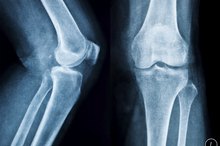Pinched Shoulder & Nerve Bicep Pain
Shoulder and bicep pain can be caused by a pinched nerve. Despite the location of the pain, this pinched nerve is often located in or near the neck, and causes pain to radiate down the arm as far as the fingers. A pinched nerve can be difficult to diagnose and treat, however, pain can often be resolved with conservative treatments.
If you are experiencing serious medical symptoms, seek emergency treatment immediately.
Identification
Cervical radiculopathy is the term for pain caused by a pinched nerve in the neck. This pain is often felt elsewhere in the arm, despite the fact that the nerve problem is located in the neck. According to the University of Maryland Spine Program, cervical radiculopathy can cause pain in the neck, shoulder or other parts of the arm, including the bicep 2.
Types
What Are the Causes of Burning Neck Pain?
Learn More
The nerves that supply the shoulder and arm exit from the cervical portion of the spinal cord, which is located in the neck. Because they travel through bone and tissues, the nerves are vulnerable to compression. The nerves leaving the neck can be “pinched” due to various conditions, including cervical spondylosis (a degenerative joint condition like arthritis), a herniated disc or bone spurs.
Effects
Because nerves carry signals for both movement and sensation, a pinched nerve can cause pain or weakness. Sometimes it causes both. Shoulder and bicep pain from a pinched nerve often feels sharp, or like it is stabbing or shooting. The shoulder and bicep may also feel numb or tingly, and may be harder to move. The same pinched nerve may also cause pain, numbness or weakness in the wrist and fingers.
- Because nerves carry signals for both movement and sensation, a pinched nerve can cause pain or weakness.
- The shoulder and bicep may also feel numb or tingly, and may be harder to move.
Diagnosis
C4 and C5 Nerve Damage Symptoms
Learn More
If you are having pain in your bicep and shoulder from a pinched nerve, your doctor can identify the problem by running a series of tests. According to the Mayo Clinic, these may include one or more of the following: • Moving your neck and arms to see whether your range of motion is limited and whether certain positions cause more pain 1. • Neurological testing, to see if the nerves in your neck and arm are functioning properly. • Performing diagnostic imaging such as an X-ray, MRI or CT scan, to check for abnormalities in tissues and bone.
- If you are having pain in your bicep and shoulder from a pinched nerve, your doctor can identify the problem by running a series of tests.
- According to the Mayo Clinic, these may include one or more of the following: • Moving your neck and arms to see whether your range of motion is limited and whether certain positions cause more pain 1.
- •
Treatment
A pinched nerve can often be treated conservatively, according to the University of Maryland Spine Program 2. Medications that reduce swelling and muscle spasms may be used initially, or a collar may be applied to the neck to restrict movement and allow for healing to take place. If this does not work, the doctor may make a physical therapy referral for range of motion exercises, or he may give a steroid injection in the area surrounding the pinched nerve. If conservative treatments fail, surgery may be required to free a pinched nerve.
- A pinched nerve can often be treated conservatively, according to the University of Maryland Spine Program 2.
- If this does not work, the doctor may make a physical therapy referral for range of motion exercises, or he may give a steroid injection in the area surrounding the pinched nerve.
Related Articles
References
- Mayo Clinic
- University of Maryland Spine Program
- Hochman MG, Zilberfarb JL. Nerves in a pinch: imaging of nerve compression syndromes. Radiol Clin North Am. 2004;42(1):221-45. doi:10.1016/S0033-8389(03)00162-3
- NIH National Institute of Neurological Disorders and Stroke. Pinched nerve information page. Updated March 27, 2019.
- AdventHealth Medical Group. Cauda equina syndrome.
- AAOS OrthoInfo. Cervical radiculopathy (pinched nerve). Updated June 2015.
- Dimitrova A, Murchison C, Oken B. Acupuncture for the treatment of peripheral neuropathy: A systematic review and meta-analysis. J Altern Complement Med. 2017;23(3):164-179. doi:10.1089/acm.2016.0155
- Conger A, Cushman DM, Speckman RA, Burnham T, Teramoto M, McCormick ZL. The Effectiveness of Fluoroscopically Guided Cervical Transforaminal Epidural Steroid Injection for the Treatment of Radicular Pain; a Systematic Review and Meta-analysis. Pain Med. 2019 Jun 10. pii: pnz127. doi:10.1093/pm/pnz127 [Epub ahead of print]
- Keating L, Treanor C, Sugrue J, Meldrum D, Bolger C, Doody C. A randomised controlled trial of multimodal physiotherapy versus advice for recent onset, painful cervical radiculopathy - the PACeR trial protocol. BMC Musculoskelet Disord. 2019 Jun 1;20(1):265. doi:10.1186/s12891-019-2639-4
Writer Bio
Erica Jacques is an occupational therapist and freelance writer with more than 15 years of combined experience. Jacques has been published on Mybackpaininfo.com and various other websites, and in "Hope Digest." She earned an occupational therapy degree from Queen Margaret University in Edinburgh, Scotland, giving her a truly global view of health and wellness.








